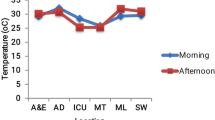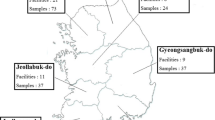Abstract
Background
The gastrointestinal endoscopy unit is frequently exposed to gastrointestinal gas expelled from patients and electrocoagulated tissue through carbonation. This can be potentially harmful to the health of not only the healthcare personnel but also patients who undergo endoscopy. This study aimed to measure the air quality in the endoscopy unit.
Methods
We measured indoor air quality indices (CO2, total volatile organic compounds (VOCs), PM2.5, NO2, CO, and ozone) using portable passive air quality monitoring sensors in the procedural area, recovery area, and cleansing-of-equipment area, at 1-min intervals for 1 week, and the type and number of endoscopic procedures were recorded.
Results
CO2, PM2.5, NO2, and ozone levels were the highest in the cleansing area, followed by the procedural and recovery areas, and VOC level was highest in the procedural area. The proportion of poor-quality level of CO2 and VOCs was highest in the procedural area and that of NO2 was highest in the cleansing area. The proportion of tolerable to poor-quality (exceeding acceptable level) level of CO2 and total VOCs in the procedural area was 26% and 19.2% in all measurement times, respectively. The proportion of tolerable to poor-quality level of NO2 in the cleansing area of the endoscopy unit was 32.1% in all measurement times. Multivariate analyses revealed that tolerable to poor-quality (exceeding acceptable level) level of VOCs was associated with the number of endoscopic procedures (odds ratio, 1.79; 95% confidence interval, 1.42–2.27) and PM2.5 level (1.27, 1.12–1.44). Moreover, tolerable to poor-quality level of CO2 was associated with the number of colonoscopy (5.35, 1.19–24.02), especially with electrocoagulation procedures (24.31, 1.31–452.44) in the procedural area.
Conclusions
Healthcare personnel and patients who undergo endoscopy are frequently exposed to ambient air pollution. Health-related protective strategies for ambient air pollution in the endoscopy unit are warranted.
ClinicalTrials.gov registration number
NCT03724565.


Similar content being viewed by others
Abbreviations
- VOCs:
-
Volatile organic compounds
- PM2.5 :
-
Particulate matter that have a diameter of less than 2.5 μm
- DALYs:
-
Disability-adjusted life-years
- CO2 :
-
Carbon dioxide
- NO2 :
-
Nitrogen dioxide
- CO:
-
Carbon monoxide
- US EPA:
-
United States Environmental Protection Agency
- WHO:
-
World Health Organization
- UL:
-
Underwriters Laboratories Inc
- NIOSH:
-
National Institute for Occupational Safety and Health
- US OSHA:
-
United States Occupational Safety and Health Administration
- ppm:
-
Parts-per-million
- ppb:
-
Parts-per-billion
- mbar:
-
Millibar
- IRB:
-
Institutional review board
- EGD:
-
Esophagogastroduodenoscopy
- CFS:
-
Colonoscopy
- ESD:
-
Endoscopic submucosal dissection
- EMR:
-
Endoscopic mucosal resection
- SFS:
-
Sigmoidoscopy
- EVL:
-
Esophageal variceal ligation
References
Han C, Kim S, Lim YH, Bae HJ, Hong YC (2018) Spatial and temporal trends of number of deaths ATTRIBUTABLE TO AMBIENT PM2.5 in the Korea. J Korean Med Sci 33:e193
Lim SS, Vos T, Flaxman AD et al (2012) A comparative risk assessment of burden of disease and injury attributable to 67 risk factors and risk factor clusters in 21 regions, 1990-2010: a systematic analysis for the Global Burden of Disease Study 2010. Lancet 380:2224–2260
Bang CS, Lee K, Choi JH et al (2018) Ambient air pollution in gastrointestinal endoscopy unit; rationale and design of a prospective study. Medicine (Baltimore) 97:e13600
Cohen AJ, Brauer M, Burnett R et al (2017) Estimates and 25-year trends of the global burden of disease attributable to ambient air pollution: an analysis of data from the Global Burden of Diseases Study 2015. Lancet 389:1907–1918
Chang M, Lee D, Park H et al (2018) Prenatal TVOCs exposure negatively influences postnatal neurobehavioral development. Sci Total Environ 618:977–981
Chang M, Park H, Ha M et al (2017) The effect of prenatal TVOC exposure on birth and infantile weight: the Mothers and Children’s Environmental Health study. Pediatr Res 82:423–428
Lee K, Choi JH, Lee S et al (2018) Indoor levels of volatile organic compounds and formaldehyde from emission sources at elderly care centers in Korea. PLoS ONE 13:e0197495
Park JS, Ikeda K (2006) Variations of formaldehyde and VOC levels during 3 years in new and older homes. Indoor Air 16:129–135
Lee SY, Chang YS, Cho SH (2013) Allergic diseases and air pollution. Asia Pac Allergy 3:145–154
Yoon HI, Hong YC, Cho SH et al (2010) Exposure to volatile organic compounds and loss of pulmonary function in the elderly. Eur Respir J 36:1270–1276
https://www.osha.gov/Publications/3430indoor-air-quality-sm.pdf. Accessed 1 Oct 2018
Erichsen Andersson A, Petzold M, Bergh I et al (2014) Comparison between mixed and laminar airflow systems in operating rooms and the influence of human factors: experiences from a Swedish orthopedic center. Am J Infect Control 42:665–669
Gormley T, Markel TA, Jones HW 3rd et al (2017) Methodology for analyzing environmental quality indicators in a dynamic operating room environment. Am J Infect Control 45:354–359
Vavricka SR, Tutuian R, Imhof A et al (2010) Air suctioning during colon biopsy forceps removal reduces bacterial air contamination in the endoscopy suite. Endoscopy 42:736–741
Perdelli F, Ottria G, Cristina ML et al (2008) Evaluation of environmental contamination by glutaraldehyde in an outpatient facility for digestive endoscopy in an Italian hospital. Int J Environ Health Res 18:73–78
Facilities Guidelines Institute (2010) Guidelines for design and construction of health care facilities. ASHE (American Society for Healthcare Engineering of the American Hospital Association). https://fgireadonly.madcad.com/readonly. Accessed 1 Oct 2018
Son BK, Kim BW, Kim WH et al (2017) Korean society of gastrointestinal endoscopy guidelines for endoscope reprocessing. Clin Endosc 50:143–147
R Core Team (2015) R: a language and environment for statistical computing. R Foundation for Statistical Computing, Vienna. https://www.R-project.org
Wickham H (2009) ggplot2: Elegant graphics for data analysis. Springer, New York
von Elm E, Altman DG, Egger M, Pocock SJ, Gøtzsche PC, Vandenbroucke JP, STROBE Initiative (2007) The strengthening the reporting of observational Studies in epidemiology (STROBE) statement: guidelines for reporting observational studies. Lancet 370:1453–1457
World Health Organization (WHO) (2017) “Air pollution”. https://www.who.int/topics/airpollution/en. Accessed 1 Oct 2018
Rajagopalan S, Al-Kindi SG, Brook RD (2018) Air pollution and cardiovascular disease: JACC state-of-the-art review. J Am Coll Cardiol 72:2054–2070
Azuma K, Kagi N, Yanagi U, Osawa H (2018) Effects of low-level inhalation exposure to carbon dioxide in indoor environments: a short review on human health and psychomotor performance. Environ Int 121:51–56
Kwon JW, Park HW, Kim WJ, Kim MG, Lee SJ (2018) Exposure to volatile organic compounds and airway inflammation. Environ Health 17:65
Loomis D, Grosse Y, Lauby-Secretan B et al (2013) The carcinogenicity of outdoor air pollution. Lancet Oncol 14:1262–1263
WHO guidelines for indoor air quality: selected pollutants (2010). https://www.euro.who.int/en/health-topics/environment-and-health/air-quality/publications/2010/who-guidelines-for-indoor-air-quality-selected-pollutants. Accessed 1 Oct 2018
Wang Y, Guo H, Zou S et al (2018) Surface O3 photochemistry over the South China Sea: application of a near-explicit chemical mechanism box model. Environ Pollut 234:155–166
Beilenhoff U, Neumann CS, Rey JF et al (2008) ESGE-ESGENA guideline: cleaning and disinfection in gastrointestinal endoscopy. Endoscopy 40:939–957
Calderwood AH, Day LW, Muthusamy VR et al (2018) ASGE guideline for infection control during GI endoscopy. Gastrointest Endosc 87:1167–1179
van den Broek PJ (2010) Bacterial aerosols during colonoscopy: something to be worried about? Endoscopy 42:755–756
Acknowledgements
C.S.B. and K.L. contributed equally to this work. This study was supported by grants from Hallym University Research Fund 2018 (H20180249).
Funding
This study was supported by grants from Hallym University Research Fund 2018 (H20180249).
Author information
Authors and Affiliations
Contributions
CSB: Conception and design of the study. CSB, KL, YJY, GHB: Generation, collection, assembly, analysis, and/or interpretation of data. CSB, KL: Drafting or revision of the manuscript. CSB: Approval of the final version of the manuscript.
Corresponding author
Ethics declarations
Disclosures
Chang Seok Bang, Keunwook Lee, Young Joo Yang, and Gwang Ho Baik have no conflicts of interest or financial ties to disclose.
Additional information
Publisher's Note
Springer Nature remains neutral with regard to jurisdictional claims in published maps and institutional affiliations.
IRB approval number Institutional review board of Chuncheon Sacred Heart hospital (NON2018-002).
Rights and permissions
About this article
Cite this article
Bang, C.S., Lee, K., Yang, Y.J. et al. Ambient air pollution in gastrointestinal endoscopy unit. Surg Endosc 34, 3795–3804 (2020). https://doi.org/10.1007/s00464-019-07144-8
Received:
Accepted:
Published:
Issue Date:
DOI: https://doi.org/10.1007/s00464-019-07144-8




